#professional architecture models
Explore tagged Tumblr posts
Text
Design Smarter with ZWCAD and SketchUp: The Modern Choice for 2D & 3D CAD Excellence
In today’s fast-paced digital design landscape, professionals across architecture, engineering, and construction are always on the lookout for efficient, affordable, and powerful CAD tools. Choosing the right design software is more than just about creating visuals—it's about productivity, accuracy, and seamless communication.
ZWCAD and SketchUp have emerged as top-tier solutions for 2D drafting and 3D modeling, trusted by millions of users globally. Both tools offer user-friendly interfaces, extensive toolsets, and flexible licensing models, making them ideal for businesses and professionals seeking high-value design platforms. Let’s explore what makes these software options stand out and how they can enhance your workflow.

ZWCAD: A Trusted Solution for 2D Design and Drafting
ZWCAD is a professional-grade 2D CAD software that has earned the trust of over 900,000 users across 90 countries. It delivers an impressive balance between functionality and affordability, offering features comparable to industry leaders but with significant long-term cost benefits.
Familiar User Interface
One of ZWCAD’s most appreciated strengths is its intuitive interface. Users can seamlessly switch between Classic and Ribbon layouts, catering to both traditional CAD users and those familiar with newer design environments. This flexibility ensures that users experience a minimal learning curve, allowing them to focus on productivity right from day one.
Compatibility with Popular CAD Standards
ZWCAD supports DWG/DXF file formats, making it highly compatible with files from other CAD platforms. If you’re transitioning from another tool, there’s no need to worry about file compatibility or losing valuable project data. Most commands and aliases remain the same, which means there's virtually no re-learning cost.
Performance and Precision
Designed with a powerful engine, ZWCAD ensures smooth operation even with large files. Features like SmartMouse, SmartSelect, and File Compare boost productivity by reducing repetitive tasks. With native support for LISP, VBA, and ZRX, it’s also highly customizable.
Perpetual Licensing Model
Unlike subscription-only software, ZWCAD offers a perpetual license—a one-time payment that gives you lifetime access. This model is especially valuable for small businesses and freelancers looking to avoid recurring costs.
SketchUp: Bringing Your Ideas to Life in 3D
While ZWCAD handles precision 2D drafting with excellence, SketchUp takes creativity to the next dimension. It’s known globally for its simplicity, speed, and versatility in 3D modeling.
Intuitive 3D Modeling Tools
SketchUp is designed to be the most intuitive way to model in 3D. Whether you're sketching out a new architectural concept or refining product designs, its interface lets you focus on your idea—not on navigating a complex toolset. This means faster iterations, better collaboration, and more efficient project development.
Versatile Design Applications
From architecture, interior design, and construction, to landscape design, film set modeling, and even game development, SketchUp finds applications across a wide array of industries. Its flexibility makes it an ideal fit for both conceptual designs and detailed construction models.
Accuracy from the Start
SketchUp isn’t just for aesthetic presentations. It allows users to design with real-world dimensions and accuracy. You can define materials, set shadows based on geographic coordinates, and even create construction documents from your 3D models. This makes it not just a design tool but a comprehensive project planning solution.
Perfect Combo for Modern Designers
When combined, ZWCAD and SketchUp offer a powerful synergy: 2D precision from ZWCAD paired with the visual storytelling and 3D capabilities of SketchUp. This makes them a dynamic duo for AEC professionals, design studios, educators, and product developers alike.
Whether you're preparing floor plans, creating construction documents, visualizing interior layouts, or building prototypes, the integrated use of both tools can streamline workflows, reduce rework, and enhance collaboration.
Why This Matters to Businesses
Choosing the right tools can significantly impact team performance, project timelines, and overall costs. Here's how ZWCAD and SketchUp provide a competitive edge:
Lower Total Cost of Ownership with perpetual licenses and no mandatory subscriptions.
Quick onboarding due to intuitive UIs and familiar command structures.
Cross-platform compatibility with popular CAD and 3D model file formats.
Scalability for growing design teams with flexible deployment options.
These features make ZWCAD and SketchUp accessible to startups, educational institutions, and large-scale enterprises alike.
Supported and Distributed by Tridax Solution
These industry-standard tools are provided and supported by Tridax Solution, a reputed name in CAD/CAM/CAE services. Tridax ensures seamless deployment, training, and support for its clients, making it easier for organizations to adopt these tools with confidence.
For more information, specifications, demo requests, or purchase inquiries, you can https://www.tridaxsolutions.com/product/zwcad/
Final Thoughts
In a world where design timelines are shrinking and client expectations are rising, adopting the right tools can make a world of difference. ZWCAD and SketchUp are two such tools that empower designers, engineers, and creatives to work smarter, faster, and more efficiently.
Whether you're just starting in design or are an experienced professional looking for a cost-effective upgrade, these platforms are well worth considering. Invest in performance, precision, and flexibility—with ZWCAD and SketchUp, you’re not just drafting or modeling; you’re shaping the future of your creative potential.
#ZWCAD software#SketchUp 3D modeling#CAD software with perpetual license#2D drafting tools#3D modeling software for architects#Tridax Solution CAD#Best alternative to AutoCAD#Professional CAD tools#SketchUp architecture design#CAD software for engineers
0 notes
Text

Master Multi AutoCAD Skills for 2D & 3D Design Like a Pro
Looking to upskill in CAD design? The Multi AutoCAD course covers 2D drafting, 3D modeling, interior layouts, civil, mechanical, and architectural drawings – all in one complete program. This course is ideal for engineers, architects, and design students who want to gain real-world AutoCAD experience across multiple domains. Learn advanced techniques, industry workflows, and design practices that align with today's project requirements. Whether you're preparing for a career in design or want to boost your professional value, Multi AutoCAD training offers the flexibility and depth you need.
Start your journey toward CAD mastery today with the right guidance and tools.
Visit Attitude Academy📚
📍 Visit Us: Yamuna Vihar | Uttam Nagar
📞 Call: +91 9654382235
🌐 Website: www.attitudetallyacademy.com
📩 Email: [email protected]
📸 Follow us on: attitudeacademy4u
#Multi AutoCAD Course#AutoCAD 2D and 3D Training#AutoCAD for Civil Engineering#AutoCAD for Mechanical Design#AutoCAD Architecture Course#Learn AutoCAD Online#Advanced AutoCAD Training#2D Drafting and 3D Modeling Course#CAD Design Course#AutoCAD Certification Course#Best AutoCAD Course#AutoCAD Training Institute#AutoCAD Classes for Beginners#AutoCAD Interior Design Course#Professional AutoCAD Program
0 notes
Text
How Drafting Services Cater to Budget and Space Constraints
Drafting services are an invaluable resource for homeowners navigating budget and space constraints. By combining creativity, technical expertise, and a client-focused approach, they ensure that your project is both cost-effective and functional.
#drafting services#professional drafting solutions#architectural drafting#residential drafting plans#commercial drafting services#autocad drafting#revit drafting experts#structural drafting plans#custom home drafting#floor plan drafting#cad drafting services#3d modeling and drafting#detailed construction drawings#remodeling drafting plans#drafting and design services
0 notes
Text

SUPERIO WAREHOSE
Visualization: GENENSE CGI
Design: SUPERIO BRAND
Location: USA, NY
Superio Brand, an esteemed American manufacturer and distributor of innovative household products, is embarking on a significant warehouse remodeling project. The company aims to optimize its warehousing capabilities and enhance operational efficiency to meet the growing demands of its expanding customer base. To achieve this, Superio Brand recognizes the value of visualizing the end result before the construction stage begins. Therefore, the company has initiated a project to create a detailed 3D rendering of the remodeled warehouse.
The primary objective of this project is to generate a realistic 3D rendering of the remodeled warehouse, enabling Superio Brand to visualize the final design before commencing the construction phase. This visualization will provide a clear understanding of the layout, spatial arrangement, and overall aesthetic of the new warehouse design.
The 3D exterior rendering will also serve as a powerful communication tool for Superio Brand, facilitating effective collaboration and alignment among various stakeholders involved in the project. Executives, architects, designers, engineers, and construction teams can all visualize the same end goal, leading to improved decision-making, reduced misunderstandings, and enhanced project coordination.
The 3D rendering can also be utilized by Superio Brand for marketing and promotional purposes. The visually appealing representation of the remodeled warehouse can be incorporated into presentations, brochures, printed catalogs, social media content etc.
#architecture#3dvisualization#rendering#cgi#archviz#3d#3d modeling#design#architecture visualization#3d architectural rendering#3d architectural visualization#3d rendering company#rendering company#visualization company#rendering firm#render company#3d rendering studio#architectural rendering company#3d rendering services#professional rendering#rendering services#exterior rendering#exterior rendering services#exterior render#exterior rendering cost#exterior building rendering#external renders#3d architectural exterior rendering#3d exterior rendering services#3d exterior rendering
0 notes
Text
#3d modeling companies in usa#3d modeling services architecture#3d modelling and rendering services#professional 3d animation services
0 notes
Text
WIP | National Simographics and Lesmana Enterprise Presents : Our World, Featuring Hitomi Okada ; Reconstruction of Almanara Castle in Porto Luminoso, Tartosa



This is Hitomi Okada,
Model, Influencer, All-year-round Traveller, and a history-arts Enthusiast.
Hitomi is no stranger to Tartosa. In fact, she travels to Tartosa a lot for her works and leisure, not minding the 8-hours-long flights she has to take to fly from Del Sol Valley.
Today, we will be following Hitomi to visit one of Lesmana Enterprise's latest Reconstruction Project in Porto Luminoso, the Almanara Al-Tartos Castle or Almanara Castle, as how the locals refer to it.

The Almanara Castle
Seated on top of a huge rock formation overlooking the Southern Tartosan coastline, is a Castle built in the 14th Century with an intricate Arabesque-moorish architecture, assimilated with Tartosan medieval architecture. Its beauty is a rare gem in Tartosa today, and Almanara Castle is currently the only one of its kind still standing in the country as a reminder of a bygone-era, of which the history books of our times refer to as the Tartosan Emirate period of 1396-1497.
In 2021, a powerful earthquake striked the coast and damaged the castle severely. In response, the Tartosan Government hired the Lesmana Enterprise to lead the reconstruction effort of the castle to restore it to its former glory.

Accompanying Hitomi Today
Are some of the best minds Lesmana Enterprise has hired to lead the reconstruction of this one-of-a-kind castle. Greeting Hitomi by the ornate gate towards the castle courtyard, are Felipe Cardona, a Lesmana Enterprise Head Reconstruction Engineer that had been working with the reconstruction of the castle since its beginning in 2021 and ; Sabrina Abdul-Zayed, a professional Archeologist from the prestigious Al-Simhara University Faculty of Archeology who had been flying back and forth to and from both countries to oversee the reconstruction of Almanara Castle.

A Heavenly Courtyard
Hitomi follows Ms. Abdul-Zayed to the picturesque courtyard where time seems to stop - the impeccable work of the engineers, craftspeople, and historians seems to keep this courtyard as how it was built in the 14th Century.
In the words of Ms. Abdul-Zayed:
"The original builders of this castle, the Al-Simharan sultanate builders, wanted to reimagine paradise by infusing masterwork craftsmanship and lush greeneries; I'm so grateful they left us with this"
As an Art-History enthusiast, Hitomi can't help but wonder:
"This place is so beautiful. But, if all the Tartosan Emirate structures had faded throughout history, why does this one still stand? "
Well luckily for Hitomi, her guide is a walking-talking encyclopedia of the Emirate's History, and knows the whole story of the Almanara Castle by heart.

What Happened to the Castle? as narrated by Sabrina Abdul-Zayed of Al-Simhara University.
After the Al-Simharan Sultanate under Sultan Yusuf VI had successfully taken over Kingdom of Tartosa from Queen Isabel de Montejo in 1396 after a four-years grueling war, the Sultan appointed his son, Emir Nizar Al-Simhari to lead Tartosa as a vassal kingdom to the sultanate. Thus, the Emirate of Tartosa or Emirate of Al-Tartos was born in the same year.
After the Al-Simharan army sets off accross the sea, the Emir needed somewhere to base his court at, and a place close enough to coast to oversee the robust southern sea trade. Thus, a much-larger palace complex was built upon Porto Luminoso's hill called the Qasr Al-Zayl.
"What you're seeing now as vineyards accross the castle is where the Al-Zayl stood about 600 years ago.", She added.

On the Final Years of the Emirate
The Emirate of Tartosa found itself at war with the western simland coalition from 1491-1496.
The Western Simland Coalition consisted of Kingdom of Henford, Kingdom of Britchester, Republic of Foxbury, Grand Duchy of Champ-les-sims, Kingdom of Windenburg, and finally the exiled Tartosan king Alfonso de Fiore XI.
The Coalition launched a full-scale invasion of the Emirate in 1491, and finally reaching Porto Luminoso in 1493, where the great 2-years siege of Al-Zayl began.



King Alfonso de Fiore himself led the siege of Al-Zayl with an overwhelming force of about 3000 men and 200 mercenaries, accumulated from 6 different nations with the same goal in mind:
End the Emirate, restore Alfonso de Fiore, and secure the southern sea trade route- where all the gold comes from.
With brutal tactics from both sides such as naval blockades, starvations, and use of early firearms, the al-Zayl finally came down in 1495, forcing the then Emir, Emir Jabar Al-Tartozi IV to seek refuge in a much more smaller castle, the Almanara.


On the Spring of 1496, the Almanara was finally breached, leaving the Emir and his last 100 men on the mercy of the besiegers.
He and his last loyal men were captured, and held prisoner in the Almanara until his execution in 1497 on the courtyard, which spells the end of the Tartosan Emirate.
To commemorate the victory over the Emirate, King Alfonso de Fiore XI spared Almanara due to its beauty, securing its place as a King's retreat after the war ended.

Good Thing they Spared this Place!
Is what the three can agree. Hitomi continues the tour to some of the castle's most beautiful halls, such as the Hall of Jenane shown in above photo.
When it is complete, the Hall of Jenane will be a museum ; and a space rentable for picturesque weddings!.

"Reconstruction of the whole castle; I can confidently say is at 90% to completion, and we can see reopening very soon around March 2025- or earlier maybe." Added Felipe Cardona.


Into the Subterrane
You will find this beautiful Azur Sanctum, a room adorned in intricate geomerty made of the finest Lazuardi and gemstones. There is also a working subterrain fountain which had been flowing without eletricity for the past 600 years!, even the air here seems a lot cooler than the air outside!.
"You know, the Emir made his last stand here with his most loyal men-the Mamluks. Many of the Mamluks perished in this very room" said Ms. Abdul-Zayed
"Okay you do not have to scare me like that" replied Hitomi.


And That ends our Short Trip for Today!
Don't forget to periodically check the Tartosan Board of Tourism for updates on the opening of the Almanara Castle!, experience the history for yourself ; or maybe plan an unforgettable wedding in the Hall of Jenane!.
Whichever you choose, don't forget to come here next time you're in Tartosa!.
I'm Hitomi Okada, and this is - Our World.
Sul-Sul!

Sim Hitomi Okada by : @mellowtrait
#simblr#lesmana-enterprise-ltd#sims 4#sims 4 aesthetic#sims 4 screenshots#ts4 simblr#sims 4 no cc#cr#showusyourbuilds#sims 4 build#sims 4 castle#sims 4 maxis match#show us your sims#show us your story#sims 4 historical#sims 4 history challenge#WIP#tartosa#sims 4 wedding#sims 4 museum#sims 4 medieval
415 notes
·
View notes
Text
FIT TO YOU
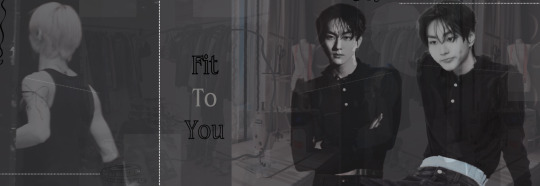
Pairing: model!Jungwon x fashion student!Reader
Synopsis: Shoulder appreciation with fluff and a bit of crack :)
Word count: 761
Author’s Notes: I had these 3 links 1. 2. 3., a crazy mind and a spare hour. If you’re in need of more shoulder appreciation check out this by @yourislandgirl (here it is, sweetheart).
Enhypen Bookshelf [[]

You had two rules as a fashion student:
Never faint in front of your models.
Never let your professor catch you eyeing Jungwon’s shoulders. (NEW)
Rule one was already teetering on the edge, and rule two was basically shredded because here he was, standing in the middle of your cramped studio, wearing a shirt that looked like it might burst any second, and shoulders wider than any human silhouette you’d ever tried to drape.
“Okay,” you said, clutching your measuring tape like a lifeline. “Let’s start with the basics.”
You tried to sound calm and professional, but your brain was doing cartwheels. How do you even begin measuring these shoulders? They might need their own zip code.
Jungwon gave you a slow, amused smile as if he knew what you were thinking. “They’re not that wide.”
You eyed him. “Yeah, well, that wide is a serious problem for someone who thinks a tape measure is a sword.”
He shrugged, and the fabric of his shirt protested dramatically, threatening to split like a bad relationship. “Fashion’s all about challenges, right?”
You gulped. “Right.”

You started with the usual—neck, chest, waist. Then came the monster: shoulder width.
“Forty-nine centimeters,” you muttered, blinking at the number as if it was a typo. “Seriously? Did you order these on purpose?”
Jungwon raised an eyebrow. “Are you implying I’m a bodybuilder?”
“Bodybuilder? No. A walking, breathing architectural marvel? Absolutely.”
He laughed, this deep, almost amused sound that made your stomach do weird flips. “I’ve been called worse.”
You snorted, accidentally dropping your tape measure on his foot. He grinned and bent down to pick it up, muscles flexing under that shirt like a perfectly sculpted statue. You tried not to stare but failed miserably.
Note to self: find a way to turn wide shoulders into a fashion statement instead of a measurement nightmare so you don't fail.

The problem with Jungwon wasn’t just his shoulders—it was that every jacket, blazer, or shirt you tried to design for him turned into a battle of wills between fabric and flesh.
One day, you tried a sleek leather jacket prototype. The first time he tried it on, you held your breath, expecting an explosion. The seams stretched with a sickening pop—but held.
Jungwon looked in the mirror, flexed once, and said, “You know, these shoulders were made to carry me.”
You blinked. “Whoa, that’s… surprisingly profound coming from you.”
He smirked. “Yeah, well, it’s the truth.”
You rolled your eyes. “Fine, but don’t quote me on that when this jacket rips in half.”

Despite the chaos, you started noticing little things. How he adjusted his stance to protect his shoulders from the world. How his shirt sleeves were always just a little too short, because finding the right length was basically an urban legend for guys with arms like his.
One afternoon, he caught you sketching him without realising.
“Are you stalking me or just obsessed with my shoulders?” he teased, crossing those impossibly broad arms over his chest.
You grinned back, not missing a beat. “Is it weird if I say a little bit of both?”
He laughed—loud, genuine—and suddenly the studio didn’t feel so cramped anymore.

Fittings became your favourite mess.
You'd pin fabric on him, only for him to break the pins by flexing. You’d gasp. He’d smirk.
“Want me to show you how annoying I can be?” he asked one day, eyes gleaming.
“Do I have a choice?”
He stepped closer, deliberately pressing those wide shoulders into your space. “Nope.”
You rolled your eyes but couldn’t stop smiling.

One night, after everyone else had gone, you stayed late to finish a jacket that was almost perfect. Jungwon was sprawled on your studio couch, scrolling through his phone, shoulders relaxed for once.
You walked over, threading your fingers along the curve of his shoulder.
“They really were made to carry you,” you murmured, the line suddenly feeling less like a joke and more like a truth.
He turned his head, surprised by the softness in your voice. “You don’t think they’re too much?”
“No,” you said. “I think they were made to carry me.”
His eyes widened just a little. “Really?”
You nodded, tracing gentle circles on his skin through the shirt.
He swallowed hard, the silence between you thick with something new and terrifying and wonderful.
Before you knew it, he’d scooped you up, arms wide and warm—shoulders carrying you effortlessly like you weighed nothing.
You gasped, clutching at his neck, breath hitching.
He winked. “Just wait until you try using them as a pillow.”

© taetebebe 2025
#enha jungwon#enhypen fanfics#enhypen ff#enhypen imagines#enhypen scenarios#jungwon ff#jungwon x reader#jungwon x y/n#jungwon x you#yang jungwon x reader#enhypen jungwon#enhypen x female reader#yang jungwon x y/n#yang jungwon x you#jungwon imagines#jungwon scenarios#reader x jungwon#jungwon#enhypen x you#enhypen x reader#enhypen fluff#enha x reader#jungwon enha#jungwon enhypen#jungwon fluff#yang jungwon fluff#jungwon angst#yang jungwon angst#bookshelf [[]
285 notes
·
View notes
Text
SUPER UNIQUE writing ideas for hobbyists and professionals looking for fun, personal projects to get their inspo back
get a fictional pen pal (ask your other writer friends!) and spend time decorating envelopes, picking out a handwriting style, maybe buying a cheap perfume/cologne that smells like your character to really get to know them and feel their presence. if you have hand tremors or bad handwriting like me, you can choose a handwriting font for them and print their letters out!! more examples: save the dates, wedding invitations, birthday cards, party invites, etc.
use old calendars in character (there are many "expired" planners on sale around the end of the year, usually August) personally, i use them to record major life events like first band tours, trips abroad, holidays, birthdays... even trash pickup days and when they forget to roll out the bins!
sketch floor plans this can be on graph paper if you have the know-how when it comes to scaling down, but there are also tons of simple apps that allow you to both create the floor plan a builder would use and add furniture like an interior decorator. some even let you rotate them afterwards and see the furniture and walls burst to life in 3D! you can think of them as the sims but where everything is actually to scale
make an architectural model if you have some scrap cardboard, paper, and glue, you can easily bring the floor plan you just made to life (you'll need practice if you want to get really fancy with it of course! window panes and railings are the gnarliest part for me, haha)
make a playlist as your character maybe the most accessible one on this list, you can make the playlist your character listens to. sometimes this can be fun and surprising, like when my little guy Possum from Violence Without Plot is covered in tattoos and plays punk music on stage but listens to nothing but spa music to wind down between shows
write something your character can see this one is so weird to summarize but what i mean is like... a school essay for your teacher character to grade. cryptic street signs warning about danger by the lake. a memorial plaque beneath a statue. a character's online blog. a few of the cards in a grandmother's recipe box. a business card for a smooth-talking lawyer. things you can write that make everything feel so textured and real
these are all things i do on the daily, and it makes my life as a writer a thousand times more joyful and fulfilling. so have fun, be safe, and don't forget to unplug the hot glue when you're done <3
1K notes
·
View notes
Text
gideon the ninth characters and their 2025 jobs
harrow: the hardest one on this list tbh. nun’s too simple, religious studies scholar isn’t insane enough. chef is too funny, as is orthopedic surgeon. we’ll go with historic preservationist, specializing in religious architecture and artifacts.
gideon: barista employee of the month, every month, at an inclusive crossfit gym. moonlights at a bar down the street some nights and is known for making sure everyone gets home safe, no matter how many asses she has to kick to the curb (literally)
palamedes: PhD and research consultant with multiple published works (research under his real name, fiction under a pseudonym). what’s the phd in? yes.
camilla: that one friend who can do anything and has done everything. certified meditation instructor? check. semi-professional martial artist? check. volunteer park ranger? check. often credited in palamedes’ works, but you didn’t even know she had a degree. throws mugs and vases in her spare time but vows to never open an etsy store
ianthe: evil woman in STEM (you pick her crime) or chain-smoking actress with a scandalous reputation and horrible interviewing manner but unmistakable talent
naberius: instagram model who is literally always filming sponsored content for a new boutique european hotel or “experience”
corona: so torn on this. either a fellow instagram model that 50% of her audience thinks is fake and 50% thinks is “actually really sweet!” or like a famous marine biologist working to save the turtles or something
jeannemary: young record-breaking olympian/pro athlete. it’s not fencing or martial arts — it’s skateboarding
isaac: internet star with a rising pop punk music career, a la noahfinnce. jeannemary did a viral drop-in to one of his songs
abigail: every gay student’s favorite history (or maybe archaeology?) professor at a world-renowned college
magnus: owner and operator of a charming pub in the quaint town where said world-renowned college is. it’s overpriced but the atmosphere and food are genuinely great
“dulcinea”: chronic illness content creator (later revealed to be grifter)
dulcinea: content creator, artist (painter), and sometimes streamer. candid and humorous about her illness, but refuses to be inspiration porn
“protesilaus”: male podcaster, incel edition
protesilaus: beloved personal trainer who privately trains for american ninja warrior on the side
silas: idk, the cuntiest bitch at the monastery? do we still have monks? can someone be a combo of trust fund baby and monk?
colum: successful practitioner of an age-old craft like blacksmithing. always taking commissions but prefers to help at historic reenactments or even ren faires. exclusively makes historically accurate pieces
judith: cop
marta: cop wait she helped harrow in the bubble so i have to be nice hard-but-fair-and-well-respected fencing instructor at a private school. she might as well be a monk for how little everyone knows about her personal life, but suspicion is rife and all the baby lesbians hope she’s got a wife (bars)
bonus: teacher: cult leader is too easy so we’ll go with “local guy who runs a shop selling crystals he bought from china at a 500% markup. he pretends they’re sustainably/ethically/lovingly sourced and guaranteed to cure your depression/anxiety/adhd but you both know he’s full of it”
79 notes
·
View notes
Text
First Sight (Chapter 1 of 7)
The elevator doors parted with a soft chime, and Dr. Carmella Hill stepped into the hushed domain of her Manhattan cardiology clinic. Her short brown hair with perfectly trimmed bangs framed her face with geometric precision, not a strand out of place despite the morning wind.
Her designer prescription glasses caught the light as she surveyed her territory, the kingdom of clean lines and medical excellence she had built through years of obsessive dedication. Her shoulders squared beneath the pristine white lab coat, its crisp edges a stark contrast to the troubled thoughts that had followed her from home. Six floors above the frenetic energy of Midtown, the clinic was a sanctuary of order.
Morning light streamed through floor-to-ceiling windows, illuminating the reception area where her staff would arrive in precisely forty-two minutes. Carmella preferred these solitary moments before the day began in earnest, when she could lose herself in the ceremony of preparation without watchful eyes or needless conversation.
Her heels clicked against the polished floor, each step an echo of purpose. She unlocked her office door with practiced efficiency, the lock yielding with a satisfying click. Inside, the space was a testament to her exacting standards—diploma and certifications arranged in perfect alignment on the walls, medical journals stacked at right angles on the glass desk, not a single item out of place.
She placed her leather bag in the same spot she did every morning, the corner of the desk nearest the window, its placement a ritual as important as any surgical procedure. From it, she withdrew her personal stethoscope, the weight of it familiar in her hands. It was the latest model, more expensive than necessary, but Carmella demanded excellence in all things, especially those that touched her patients.
The instrument gleamed under the overhead lights as she polished it with a microfiber cloth, her movements deliberate and reverent. Her fingers lingered on the chest piece, tracing its perfect circumference with an attention that transcended mere professional care.
She felt a flutter in her abdomen, a quickening of her pulse that had nothing to do with the morning's exertion and everything to do with what this instrument allowed her to hear—the most intimate rhythm of life itself.
She placed the stethoscope around her neck, adjusting it with unusual deliberation. The cool metal settled against her skin, and she closed her eyes briefly, savoring the sensation. When she opened them again, her reflection in the small desk mirror caught her attention, and she paused to study herself.
The woman who stared back was the picture of professional composure—high cheekbones accentuated by the angles of her glasses, lips pressed into a disciplined line. But beneath the clinical detachment, she recognized the telltale signs of her private fascination: the slight dilation of her pupils, the faint flush along her collarbanes.
Carmella shrugged off her lab coat and hung it temporarily, taking a moment to assess her physical form in the full-length mirror on the back of her door. Years of rigorous dedication to fitness had sculpted her body into something extraordinary. Her silk blouse clung to her large breasts, their perfect roundness defying gravity with the help of an expensive, architectural bra. The tailored slacks sat low on her hips, revealing the ridges of her enviable six-pack abs when she turned to the side.
She flexed slightly, watching the definition of her muscular thighs press against the fine fabric. The body was a machine, she reminded herself. Her own was simply better maintained than most. Still, she couldn't help but feel a flicker of pride at the exceptional vessel she had crafted through unrelenting discipline.
She donned her lab coat again, the white garment settling over her curves with professional neutrality, though it did little to conceal the remarkable physicality beneath. One by one, she checked each examination room, arranging instruments with obsessive precision. Blood pressure cuffs were coiled with mathematical exactness, cotton swabs aligned in perfect rows, vials organized by size and purpose.
In the central examination room, she paused, her attention caught by the gleaming array of cardiac monitoring equipment. Her fingers skimmed across the surface of the ECG machine, the metal cool against her skin. Her practice had the most advanced technology available, allowing her to capture every nuance of the heart's electrical activity, to see on screen what she could hear through her stethoscope.
She moved to her desk and pulled the day's patient files, spreading them before her in a fan of medical histories and heart conditions. Each folder was color-coded, the contents arranged according to her exacting specifications. She reviewed them methodically, committing key details to memory, noting the two new referrals and their symptoms with particular interest.
The first was a thirty-four-year-old woman with complaints of occasional palpitations during exercise. Carmella studied the preliminary notes, her mind already constructing a sequence of tests to isolate the cause. Her fingers traced the lines of the intake form, lingering on the patient's age and described symptoms. She anticipated the examination with a sharpness that was both professional and something more—an interest that went beyond clinical curiosity.
She returned the stethoscope to her neck, adjusting it once more with precise attention. The weight of it was reassuring, a connection to the rhythm she would soon hear, measure, analyze. She ran her fingertips along the tubing, the sensation triggering a memory of yesterday's examination—the cadence of a particular heartbeat that had stayed with her, replaying in her mind as she had lain awake last night.
The clinic remained silent around her as she completed her preparations. She set out the day's schedule, checked the calibration of the blood pressure monitor, and made one final adjustment to the arrangement of instruments on the examination tray. Each action was performed with meticulous attention, her body moving through the space with the confidence of absolute ownership.
Finally, she stood before the mirror once more, checking her appearance with critical eyes. She tucked a stray strand of hair behind her ear and straightened the lapels of her lab coat. The stethoscope hung precisely centered, the silver chest piece catching the light. Her hand rose to it, fingers closing around the metal in a gesture that was almost protective.
Carmella drew a deep breath, tasting the antiseptic cleanness of the air. She was ready for the day, her professional armor intact, her personal fascinations safely concealed beneath layers of clinical expertise. She glanced at her watch—seven minutes until her receptionist would arrive, twenty-three until the first patient.
The day would unfold with the precision she demanded, each heartbeat she listened to cataloged and analyzed with scientific detachment. But beneath the sterile surface of her professionalism, beneath the controlled rhythm of her own heartbeat, ran a current of something unruly and demanding—a fascination with the pulse of life that transcended medical interest and veered into territory more complex, more consuming.
The stethoscope rested against her chest, a constant reminder of the sound she sought, the rhythm that obsessed her. Her fingers brushed against it once more, an unconscious gesture of anticipation, before she turned to her desk to await the arrival of her staff and the day's first heartbeat.
The examination room was a testament to minimalist luxury, all clean lines and subdued tones. Sunlight streamed through the floor-to-ceiling windows, offering a panoramic view of the Manhattan skyline—a vista that patients often found distracting enough to momentarily forget their cardiac concerns.
Carmella appreciated this effect; a relaxed patient yielded more accurate readings. She arranged the instruments on the silver tray with methodical precision, each item placed at the exact angle she preferred, the metal surfaces gleaming under the recessed lighting. The scent of antiseptic hung in the air, sharp and clean, a counterpoint to the faint trace of the patient's perfume that had entered the room before her.
Ms. Chen sat on the edge of the examination table, her silk blouse unbuttoned just enough to allow access for the stethoscope. Early thirties, Carmella estimated, with the lean physique of someone who exercised regularly but not obsessively. Her dark hair fell in an elegant bob that framed an oval face with high cheekbones.
The referral note mentioned occasional heart palpitations during her morning runs, nothing that seemed particularly concerning on paper, but Carmella never dismissed cardiac symptoms, no matter how minor. "So you've been experiencing these palpitations for about three weeks?" Carmella kept her voice professionally neutral as she reviewed the intake form, her eyes scanning the notes with practiced efficiency.
"Yes, usually about ten minutes into my run." Ms. Chen's voice was melodic, with the slight rasp of someone who enjoyed the occasional cigarette despite knowing better. "It's probably nothing, but my GP thought I should see a specialist."
"Palpitations are always worth investigating," Carmella replied, setting down the chart. She moved to the sink and washed her hands with meticulous attention, counting silently as she always did—twenty seconds exactly, no more, no less.
"Even if they turn out to be benign, which is often the case." She dried her hands on a paper towel and turned back to Ms. Chen, her professional mask firmly in place. "I'm going to take your vitals first, then listen to your heart in various positions to see if we can identify any irregularities."
The preliminary checks proceeded with clinical precision. Blood pressure: 118/76. Pulse: 72 beats per minute, regular. Oxygen saturation: 99%. All textbook normal. Carmella noted each value in the chart, her handwriting as precise as her methodology. "Now I'll need to listen to your heart," she said, reaching for the stethoscope that hung around her neck.
Her fingers closed around the chest piece, the metal warming beneath her touch. A subtle flutter stirred in her stomach, a physical anticipation she acknowledged and then attempted to suppress. This was a medical procedure, nothing more. "Could you unbutton your blouse a bit further, please? I need access to several listening points."
Ms. Chen complied without hesitation, the silk parting to reveal a lace-trimmed camisole beneath. Carmella kept her gaze clinical, focused on the anatomical landmarks that would guide her examination, not on the swell of the woman's breasts or the delicate hollow of her throat where a pulse visibly fluttered.
"This might be a bit cold," she warned, a standard phrase that fell from her lips automatically as she placed the stethoscope's disc against Ms. Chen's chest, just to the right of her sternum.
The first heart sound filled Carmella's ears—a clean, strong "lub" followed by the softer "dub" of the closing valves. The rhythm was like a well-conducted orchestra, each beat precise and distinct. Carmella felt her own pulse quicken in response, a pavlovian reaction to the intimate sound. She closed her eyes briefly, allowing herself to focus entirely on the auditory input.
Ms. Chen's heartbeat was remarkably clear, unusually so. Each component of the cardiac cycle resonated with crystal clarity through the stethoscope's earpieces. Carmella detected no murmurs, no extra sounds, just the pure, perfect rhythm of a healthy heart pushing blood through its chambers with textbook efficiency. She moved the stethoscope incrementally, tracking across the chest to the next auscultation point.
Ms. Chen's skin was warm beneath the cold metal disc, the contrast sending a nearly imperceptible shiver through Carmella's fingers. She noted the patient's even breathing, the slight rise and fall of her chest beneath the stethoscope, a counterpoint to the heart's rhythm.
"Deep breath in, please," Carmella instructed, her voice betraying none of the inappropriate fascination building within her. As Ms. Chen inhaled, her heart rate increased slightly, accelerating in response to the expanded lung capacity. Carmella listened intently, caught in the peculiar intimacy of the moment—privy to the most internal rhythm of another human being, a sound that the woman herself could never hear with such clarity.
Carmella's pupils dilated behind her designer glasses, the clinical part of her brain registering this physiological response even as she continued the examination. Her own breathing had subtly shifted, synchronizing with the patient's unconsciously. The examination room, with its panoramic view and pristine surfaces, seemed to recede, leaving only the connection between her ears and the pulsing heart beneath her hand.
She lingered longer than strictly necessary at the mitral area, telling herself she was being thorough, searching for any hint of a murmur or irregularity. In truth, she was savoring the sound, storing it in her memory like a collector acquiring a particularly fine specimen. Each heartbeat resonated through her, sparking an interest that was far from professional.
"Now I'll need you to lie back," she said, her voice steady despite the inappropriate warmth spreading through her core. "I want to listen with you in a supine position." As Ms. Chen reclined on the examination table, Carmella repositioned the stethoscope, pressing it perhaps a fraction more firmly than required against the soft skin.
The change in position altered the heart sounds slightly, bringing the S3 into clearer focus—that subtle, low-frequency extra sound that followed the main "lub-dub" in some patients. Not a pathological finding in a young, fit woman like Ms. Chen, but its presence added another layer of complexity to the cardiac symphony that now filled Carmella's consciousness.
Time seemed to stretch as she listened, her professional detachment slipping further with each beat. Her hand rested on the examination table beside Ms. Chen's shoulder, and she noticed with distant alarm that her fingers trembled slightly. She curled them into a loose fist, concealing the evidence of her unprofessional response.
"Everything sounds normal so far," she managed, her voice clinical despite the heat that had crept up her neck to flush her cheeks. She hoped the patient would attribute any redness to the room's temperature. "But I'd like to check one more position. Could you turn onto your left side, please?"
Ms. Chen complied, her movements causing a momentary interruption in the cardiac soundtrack. Carmella waited, stethoscope poised, for the woman to settle. When she placed the disc back against skin, the heart sounds were at their most audible, the left lateral position bringing the organ closest to the chest wall.
The beat filled her ears, strong and insistent, and Carmella closed her eyes again, fully absorbed in the forbidden pleasure of listening. Her breath caught in her throat, and for a perilous moment, she feared the patient might notice her inappropriate reaction. But Ms. Chen lay still, eyes fixed on the ceiling, perfectly unaware of the storm brewing within her cardiologist.
With tremendous effort, Carmella pulled herself back from the brink of complete unprofessionalism. She removed the stethoscope, letting it hang once more around her neck, the chest piece still warm from contact with Ms. Chen's skin.
"You can sit up now," she said, her voice sounding distant to her own ears. "I don't hear any abnormalities, which is excellent news." Ms. Chen rebuttoned her blouse, her movements unhurried and graceful. "So the palpitations aren't serious?"
"They're likely benign, possibly related to mild exercise-induced tachycardia," Carmella replied, falling back on medical terminology like a shield. "But I'd like to run an ECG to be certain, and perhaps have you wear a Holter monitor for twenty-four hours to catch any irregularities that might occur during your next run."
Her hands trembled slightly as she made notes in the patient's chart. The pen skittered across the page, leaving marks that were less precise than her usual immaculate script. She pressed down harder, forcing control, but her fingers remained unsteady—betrayers to the last.
"The nurse will set you up with the ECG in a moment," she said, not quite meeting Ms. Chen's eyes. "And we'll schedule the Holter monitor fitting at reception." Ms. Chen nodded, seemingly oblivious to her doctor's internal turmoil. "Thank you, Dr. Hill. Everyone says you're the best, and I can see why."
The compliment cut through Carmella like a blade of ice. If only her patient knew the unprofessional thoughts that had accompanied her examination, the way the sound of her heartbeat would echo in Carmella's mind long after she left the clinic.
The shame of it mingled with the lingering arousal, creating a toxic cocktail of emotion that threatened to crack her professional veneer. "Just doing my job," she replied, the platitude tasting stale on her tongue. She stood, clipboard clutched to her chest like armor. "The nurse will be right in."
She exited the room with measured steps, her outward composure a masterpiece of control, betrayed only by the slight tremor in her hands and the memory of a heartbeat that continued to pulse through her consciousness with inappropriate persistence. Carmella closed her office door with a soft click and leaned against it, finally allowing her composure to fracture in the privacy of her sanctuary.
The stethoscope hung heavy around her neck, still warm from contact with Ms. Chen's skin, the memory of the heartbeat pulsing through her consciousness with merciless clarity. Her own heart raced with inappropriate excitement, its rhythm a mockery of the professional demeanor she had struggled to maintain during the examination.
Her hands, steady enough during medical school surgeries and countless cardiac emergencies, now trembled with the force of her desire, and she felt a flush of shame spread beneath her skin like a fever. She crossed to her desk on unsteady legs, grateful for the solidity of the leather chair that caught her as her knees weakened.
The morning sun still streamed through the windows, the city sprawling below her in its indifferent enormity, but Carmella was blind to everything except the echo of that perfect rhythm in her mind. Her fingers found the stethoscope, lifting it from around her neck with a reverence that bordered on worship.
The metal chest piece retained a whisper of warmth, and she closed her eyes as she held it, replaying the sound that had filled her ears moments ago. The cadence of Ms. Chen's heartbeat—strong, regular, with that subtle S3 presence—had been exquisite, a symphony of life force that resonated through Carmella with nearly unbearable intensity.
She pressed the chest piece to her own sternum, seeking the counterpoint of her racing heart, the comparison between her irregular, desire-quickened pulse and the memory of the patient's perfect rhythm. Her heartbeat sounded shallow and frantic through the instrument, a testament to the unprofessional arousal that now consumed her.
"Control yourself," she whispered, the words sharp in the silence of her office. But even as she issued the command, her mind betrayed her, reconstructing the examination in vivid detail—the warmth of Ms. Chen's skin, the slight rise and fall of her chest with each breath, the way the heart's rhythm had changed subtly when she'd shifted position.
Carmella set the stethoscope on the desk, forcing her hands away from the instrument that had become both her professional tool and the conduit for her most private obsession. She'd chosen cardiology with genuine passion for the science, fascinated by the heart's mechanical perfection, its tireless commitment to sustaining life. When had that academic interest evolved into something so personal, so consuming?
Perhaps it had started during her residency, when a particularly striking patient's heartbeat had caught her attention, its rhythm unusually clear and compelling. Or maybe the seeds had been planted earlier, in the anatomy lab when she'd first held a preserved heart in her hands, marveling at the vessel that contained humanity's most potent metaphor for emotion.
Regardless of its origins, the fascination had grown over the years, intensifying until the sound of a heartbeat—particularly a female heartbeat, with its higher pitch and faster baseline rhythm—could send her spiraling into this state of inappropriate arousal. The professional detachment she maintained with steel discipline was her only defense against the tide of her fixation.
Carmella's cheeks burned as she acknowledged the physical signs of her arousal—the heightened sensitivity of her skin, the tightness in her chest, the unmistakable throb of desire between her legs. Her body's response was as clear as any diagnostic reading on her medical equipment, and it filled her with a tangled knot of shame and excitement.
She was a respected cardiologist, a specialist who had published in prestigious journals and lectured at international conferences. Her professional reputation was impeccable, built on years of dedicated study and practice. Yet beneath the perfect exterior lurked this fascination that threatened to undermine everything she had worked for.
What would her colleagues think if they knew? What would her patients feel if they discovered that their doctor listened to their hearts with more than clinical interest? The potential for scandal was enormous, a career-ending possibility that she couldn't afford to ignore.
Yet the intensity of her response was undeniable, a physiological fact as real as any cardiac condition she diagnosed. Her fingers trembled as she reached for a glass of water, trying to cool the heat that had spread through her body. The liquid did little to extinguish the fire that Ms. Chen's heartbeat had ignited.
Carmella forced herself to breathe deeply, employing the same techniques she recommended to anxious patients. In through the nose, out through the mouth. Slow, controlled, deliberate. The rhythm of her own breathing became a focus point, a way to anchor herself in the storm of her desires.
She justified her interest with scientific rationale—wasn't the heart the most fascinating organ in the human body? Its ceaseless rhythm, its complex electrical pathways, its crucial role in sustaining life made it worthy of devoted study. Her fascination was merely an extension of her professional dedication, a heightened appreciation for the subject of her expertise.
But the scientific explanation rang hollow, even to her own ears. What she felt when listening to a heart like Ms. Chen's transcended academic interest. It was visceral, primal, and undeniably sexual—an inappropriate response that she struggled to reconcile with her professional identity.
The stethoscope caught the light as it lay on her desk, a silver beacon that both represented her medical authority and embodied her deepest temptation. Carmella stared at it, caught in the contradiction of her feelings—pride in her expertise mingled with shame over her secret arousal.
She squared her shoulders, determination hardening her resolve. This fascination may have a hold on her, but she wouldn't allow it to compromise her professional standards. The line between appreciation and exploitation was clear, and she would never cross it. Her patients deserved a doctor who put their care above all else, regardless of her private struggles.
Rising from her chair, Carmella moved to the small bathroom adjoining her office. She splashed cold water on her face, the shock of it helping to clear her mind. In the mirror, her reflection showed the evidence of her inner turmoil—dilated pupils, flushed cheeks, a brightness in her eyes that spoke of unresolved tension.
She dried her face with methodical care, then reapplied her subtle makeup with practiced precision. Each stroke of the lipstick, each touch of the powder brush was an act of reconstruction, rebuilding the façade that had momentarily cracked.
Her lab coat hung on the back of the door, and she straightened it meticulously, adjusting the lapels until they fell in perfect symmetry. She would not allow her private obsession to undermine the professionalism she had spent a lifetime cultivating.
The stethoscope waited on her desk, and she approached it with newfound determination. She picked it up, wiped it thoroughly with an alcohol swab, eradicating any trace of warmth or memory. When she placed it around her neck once more, it was as a medical instrument only, its purpose reclaimed from the realm of inappropriate fascination.
Carmella checked her appearance one final time in the small mirror on her desk. The woman who looked back at her was the consummate professional—composed, authoritative, in complete control. No one looking at her would see the turmoil that still simmered beneath the surface, the echo of a heartbeat that continued to haunt her thoughts. She straightened her spine, adjusted her glasses, and reached for the intercom.
"Please send in the next patient," she said, her voice steady and confident, betraying none of the conflict that raged within her. The professional mask was firmly back in place, the perfect image of medical expertise restored.
But as she waited for the door to open, her fingers unconsciously brushed against the stethoscope at her chest, a fleeting touch that acknowledged the truth she could never fully escape—that beneath the pristine white coat and years of training beat a heart as susceptible to inappropriate desire as any she had ever examined.
#cardiophile#female heart#cardiophile thoughts#stethoscope#heartbeat kink#cardiology#heartbeat#dr. carmella hill#red filled fantasies
36 notes
·
View notes
Text
L x Reader pt. 13: The Billionaire and The Prostitute
This chapter starts with a song playing in the background, I HIGHLY recommend you listen along!
I don't know about anyone else, but I listen to music with every chapter I write (usually romantic goth), I feel like it elevates the experience so much :)
Also sorry this took longer than usual, I didn't realize it's been a while 😭

You turn up the radio. "These Boots Are Made for Walkin'" by Nancy Sinatra.
Your back was supported by the black leather of your brand new, hot pink convertible, classic model of course. It cruised down the long, open road, the slow upward incline hardly impeding your speed.
You keep sayin, you've got somethin' for me.
Something you call love, but confess-
You adjust your grip on the leather steering wheel.
You've been a-messin'
Where you shouldn't have been a-messin'.
You adjust the mirror to look back at all your shopping bags.
and now someone else
Is gettin' all your best.
These Boots are made for walkin'
And that's just what they'll do.
one of these days these boots are gonna
Walk all over
You.
You flip your pink sunglasses down and onto your nosebridge, the Cartier logo on the side glinting in the sunlight as you take a curve.
You keep lyin', when you oughta be truthin'.
You grip the wheel a little tighter.
And you keep losin', when you oughta not bet.
you keep samin', when you oughta be changin'
Your eyes flick once more to the mirror.
now what's right is right, but you ain't been right yet.
Your lip gloss glittered in the light, maybe expensive brands were better than cheap.
these boots are made for walkin'
And that's just what they'll do.
one of these days these boots are gonna
Walk all over
You.
The air blew through your ponytail, across your bare shoulders, your only cover your pink tube top and black slacks, along with your black Louboutin stilettos.
You keep playin' where you shouldn't be playin'
You spot, far in the distance, a red speck meant to be a stop sign.
and you keep thinking
that you'll never get burned (ha!).
I just found me,
A brand new box of matches, yeah.
And what he knows, you ain't have time to learn.
your foot slowly presses the gas pedal.
60.
These boots were made for walkin'
70.
And that's just what they'll do.
80.
One of these days these boots are gonna
90.
Walk all over
100.
You.
you slam on the break, and skid to a complete stop just before the sign.
Are you ready boots?
Start walkin'!
As the song closes out, and your eyes focus on the octogon sign, adrenaline rushes your system. Heart-pumping, blood-rushing, head-dizzying adrenaline.
And it's the best you've felt in weeks.
You turn the radio off, and continue driving in complete silence.
You find yourself in your new driveway, not sure how you got there so fast.
You drove, of course, but you were so zoned out for the rest of the ride that you surprised yourself when you actually reached your destination.
You sigh, and remove the keys from the ignition. The sunset left the sky purple above you, but your beautiful new house was bathed in an orange glow.
L had it built just for you, and surprisingly fast. It only took a few months, which you spent in a deluxe hotel room, on his dime.
He had you oversee each detail, what you wanted and what you didn't, down to the last rose in the garden.
It had classic Victorian architecture, the kind of house you'd gawk at when you pass by. It was characteristic in color and structure, a romantic red-pink shade combined with white detailing in the roof tiles and columns. It matched your vintage car, and while the sight pleased a part of you that craved the aesthetics, stepping inside with all of your shopping bags and new clothes dampened the mood with heavy guilt.
Walking through the professional-grade kitchen didn't fill you with joy so much as remorse. The walk-in closet with the revolving door for shoes and purses brought you a temporary pleasure, and the frequent shopping trips did nothing to fill the void in your chest.
You settled yourself in front of your new vanity, and began to test all your new makeup. Too thick, too light, too red, too yellow.
some things weren't the best, others were exactly what you wanted. You'd give the stuff that didn't suite you to your friends.
You'd give as much as you could away. You thought this guilt might be helped with charity. Any clothes you didn't quite like, any food you had in excess, whatever could be handed off.
Your phone rings, and you looked over at the brand new device. It had a custom design, with glittery pink buttons, and a camera that registers more than 5 pixels. Your ringtone was customized too, Yummy by Ayesha Erotica. You pick it up.
"Yeah?"
"Are you settled?"
Its the calm, smooth voice that activates the sinking feeling in your stomach. You were guilty because you felt you were taking advantage of him.
"I am..." you only moved in a week ago, you haven't seen him since then.
"I'd like to see you tonight." He was so polite about it.
"Alright. for what?"
"For sex."
It's been a while since you've had sex. You could barely hold a real conversation with him after...well. you know. "Ok. I'll see you at..."
"9. Watari will drive you."
"Cool. Bye."
"Goodbye."
~~~~~~~~~~~~~~~~~~~~~~~~~~~~~~~~~~~~~~~~~~~~~~
L hangs up, and gently sets the phone on the table in front of him. You've become more reserved lately, more nervous. He knows why, he just doesn't like it. His confession was a surprise to both of you, but you took it in a different way. You seemed to draw back, to hide, to become snippy and defensive on somedays, and remorsefully polite on others. Like a cat he once knew.
He, on the other hand, hasn't felt better. He knows what's wrong with him now: it was thoughtless amor. It was something he could manage, now that he was aware of it. It also meant he could solve some of his endless enui with your presence. You comforted him, even in your frustration. He hoped that one day, you would grow to...tolerate him.
Don't get him wrong, he wasn't holding you captive. Your contract clearly defined that you could withdraw consent for any reason or no reason at all, and keep anything you might have accumulated in his care. It was a safeguard for you. Though...there wasn't much for you to leave to...it was an unfortunate circumstance, what brought you here.
For now, L could only wait for your arrival. He wanted to feel your skin against his, for the first time in quite a while. It would make him feel closer to you, and...he had his own theories on the effects It might have on you.
~~~~~~~~~~~~~~~~~~~~~~~~~~~~~~~~~~~~~~~~~~~~~~
As you rode to L's hotel, you concluded two things:
One, you can't bring yourself to have a normal conversation with L.
And two...the only way to avoid a normal conversation was to never give him a chance to conversate. You would do what you know.
You marched into the hotel with a mission. You followed protocol, as always, picking at the skin by your nails the whole way through. Would he be ok with it? Would he allow you to just...
He probably would. You've noticed he likes that sort of thing.
you stride to the penthouse door as soon as the elevator lets out, and try the handle. It opens.
"I'm here," you announce. You can see his hair peeking out from above the back of the couch. Before he can acknowledge you, you're already sliding into the seat beside him.
"Good ev-"
Your lips crash onto his. He stiffens, eyes wider than usual. His curled posture keeps him sturdy against your movement, and your fingers splaying against his cheek hold him to you. What were you doing?
When you finally pull back, he stares wordlessly at you. His expression was enough to say what his mouth didn't. Explain yourself.
"What? You said you wanted sex, right?" Here you were, getting defensive again.
"I did..." he nods.
You rest your hands on his shoulders, and slink into his lap. Despite his confusion, he holds your waist. Were you finally coming around? Was this tolerance?
"Then shut up. Kay?"
His brows shoot up in surprise, but he can't respond with your mouth ravenously attacking his.
He should tell you to calm down, clearly there was something more here, but...what if asking you to stop would deter you? What if you never come to him like this again? this passion you were showing, the way your hands rushed to tug off his shirt...
He lifts his arms, and once the fabric is off he embraces you. His arms wrap around your back, keeping you tight to his chest. His long fingers trace the lines of your dress until he finds the zipper, and carefully tugs it down. You shove the dress off of your shoulders, until it bunches at your middle and you can remove it over your head.
You were wearing the lingerie set he bought you. L gently traces the floral lace pattern, how it curved over the shape of your breast. You reach back and snap the bra off, your impatience impeding his loving gesture.
He leans in, and presses delicate kisses to your chest as you yank at his pants. He shifts to allow the undressing, and before he knows it the both of you are completely naked. When did you take your panties off?
When your mouth finds his again, it's to keep him still as you grip his cock. You pump his half-flaccid member once, twice, three times, until he's nice and hard.
He pulls away to speak, but you find purchase on his neck. The little pecks and nips leave him breathless, he hardly notices how you slide down and onto your knees. "(Y/n)-"
You wrap your lips around his tip. Can't have a conversation if your mouth is full.
He shudders, and drives a hand into your hair. "You're being-" he moans as you lick a stripe up the vein that ran through his cock- "childish..."
Your eyes narrow, and you kiss the base of his cock. You had no words for him, you were busy working. That's all this was to you, a job. And it would stay that way.
He watched with perplexed interest as you lapped the pre off of his dick, before sliding the tip into your mouth once more to lightly suck. He had to admit, you were very good at this. His toes curled into the hotel carpet as you took him deeper, his heavy pants and sighs betraying his necessity to get an answer from you. You were making it difficult to talk, no doubt on purpose. He didn't want to compromise, to fall for this hedonistic bribery into silence...
...but your lowered lashes flicked up, and held his gaze as you lap at his balls while his heavy, twitching dick rested on your forehead. He could see the curve of your ass so nicely from here. Your breasts hung, not held with a bra, and those pretty nipples sloped outward, tantalizing. He wanted them in his mouth. And he wanted your mouth around his cock.
He would allow this. But as his own way of getting back at you, he waited until you were at his tip again, strengthened the grip in your hair, and forced your head down. You gagged, but took a determined breath through your nose, and allowed him to guide you up and down.
It was funny to him. You were clearly trying to avoid conversation, but this was it's own communication. Each flick of your tongue, each sigh in your throat, each narrowing of your gaze- it all spoke. Fuck you, for making it so complicated.
And, in response, he had is own mannerisms. How his thumb slid up and down your forehead, how his chest vibrated in gentle groans, how his hip tentatively bucked upward- I love you, very much.
Fuck you.
I love you.
This is hell.
I love you.
I hate you.
I love you.
He grunted out a reverent moan as his hips lurched off of the couch, ribbons of cum painting the back of your mouth a translucent, syrupy white.
Your throat clamps around him as you swallow, over and over, the sensation enough to send him into another feverish craving for release.
When the tension in his thighs ease, and his panting slows, you pull away from him. You take a gulp of air to calm yourself, and stand. "You probably need water," you mumble, turning to walk to the fridge. "I'll be-"
He grabs your wrist, and tugs you onto the couch. You look at him in much the same way as he looked when you went down on him without warning. "That won't be necessary. I'd like to return the favor, if that's alright with you."
His eyes glint with challenge. If you wanted to be childish, so would he. He loved you, yes, but he wouldn't just sit here and let you squander your time with one-sided pettiness. He would be petty, too.
You frown. "Fine. If that's what you want."
"It is. Lay back, unless you'd like to move to the bed."
"Here's fine," you shrug. You couldn't care less.
L watches as you set your head on the armrest. You spread for him, just as always. One foot anchored on the back of the couch, the other foot settled on the floor. You looked just as sticky and sweet as the first time.
He eases his hands onto your hips, at first to caress the skin, then to hold you secure. He's sure to hold eye contact as he finally brings his mouth to your aching clit, his slow, preliminary licking as analytical as always.
You moan. You squirm. You look so delicious when your hips roll. Before long, he has your hand gripping his hair to hold him in place as he slurps up your juices, tongue prodding and lapping with accute precision to bring you the most pleasure.
Your sounds raise in volume, the steady oohs and ahhs becoming more than idle panting.
Just as you begin to see those stars, he stops.
He pulls back, and leaves you just before the crescendo of your orgasm.
Your legs snap shut in an attempt to supplement the stimulation, but it's too late. "L," you curse. How dare he deprive you? Who was he, to stop in the middle of it all?
"What's the matter," he asks lowly. His gaze is sharp, searching. He was toying with you.
Or worse.
Looking for an answer.
You frown at him. "Don't be an asshole."
"I'd be happy to give you what you need, if you ask for it."
He wanted you to beg? Is that what this was?
You roll your eyes, but...he looks serious.
Well. It was your job.
You pout. You tilt your head. "Please..." you purr, slowly sitting upright. He watches you move, like you were an unpredictable animal. Your hand finds his jaw, and you grip his cheeks with urgency. "I wanna cum on your face."
Somehow, even with you doing the begging, it still felt like he was the one at your mercy.
You can feel him shiver. You've got him wrapped around your finger.
His sharp gaze wavers from your face to your dripping cunt, unable to focus as you lay back once more. His chest drops inward with the release of the breath he didn't realize he was holding, before he dives back in to finish the job.
Past the the sounds of his own groaning, he could hear the satisfaction in your voice, feel the way you tense as his tongue pushes itself inside you. His blunt nails scratch against your skin as he pulls you impossibly closer, like he's trying to taste your cervix.
"Mn...fuck," you whine.
If the fluttering of your walls weren't a tell, that was. His hand snaked around to rub at your clit, which in turn caused your hips to jolt upward. You were so sensitive now that he had teased you like that...so loud, too. He's learned from this.
Teasing was a tool best used for making your scream.
~~~~~~~~~~~~~~~~~~~~~~~~~~~~~~~~~~~~~~~~~~~~~~
You wake up in L's bed, warm and naked. You don't want to get up, it's nice here, buried in the comforter, swallowed in relaxation.
What were you thinking?
You shoot upright. You were going home. Home, to your disgustingly expensive car, and your disgustingly expensive mansion, to live a disgustingly expensive life. You weren't here to get comfortable, you were here to earn your lifestyle. It was a trade-off, nothing more.
You stand, but your legs wobble from overuse before you can bolt like you wanted to. Damn L.
Your clothes are in the living room. Do you really want to see L out there, and risk actually talking to him? Maybe you can just walk home naked.
You groan, and trudge to the door. As you reach for the handle, the door swings open. You shriek, and stumble back.
"Fuck," you gasp, realizing the instant you speak that it's just L. Of course.
"Good, you're awake. You've been asleep for quite some time. I worried you were dead."
"Are you being sarcastic? Thats a weird thing to worry about," you grumble.
He doesn't react to your grumpy demeanor. "Are you leaving?"
"Yeah. I need my clothes."
He steps to the side, and you brush past him. As you pull your old things on, he watches with little more than curiosity.
"Do you like sun dresses?"
You shrug as you snap your bra back together. "I do. Why?"
"Nothing of interest to you."
You always hated that answer from him. "Ok...well, I'm headed out, bye."
You wave and walk to the door. He makes no motion. "Goodbye."
"I love you."
you pause, just before you grab the handle. This is what you were scared of.
"I don't," you spit. Like venom, like everything wrong in life was his fault. Like the goo in your chest meant something you don't understand, you refuse to understand.
"I know." He was quiet, and gentle. Just like the first time he said it.
You snatch up the door handle, and storm out.
He's left with the sound of the door slamming shut.
You're left with the heat in your cheeks.
Neither of you can face the reality you're presented.
#fanfic#fan fiction#l lawlight#l lawilet#l lawiet#l x reader#l death note#death note#death note l#death note fanfiction#death note smut#l lawliet smut#ficlet#short ficlet#death note fic#main universe#possible wip#current wip#Writeblr#deathnote#Death note#light yagami#l lawliet x reader#writers on tumblr#writing#fanfic series#fanfiction#ao3 fanfic#tumblr fanfiction
53 notes
·
View notes
Text
Immediate Murder Professionals, before the Full Moon deal...
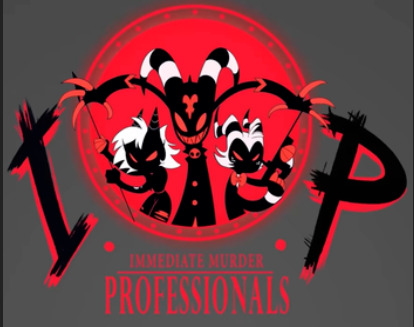
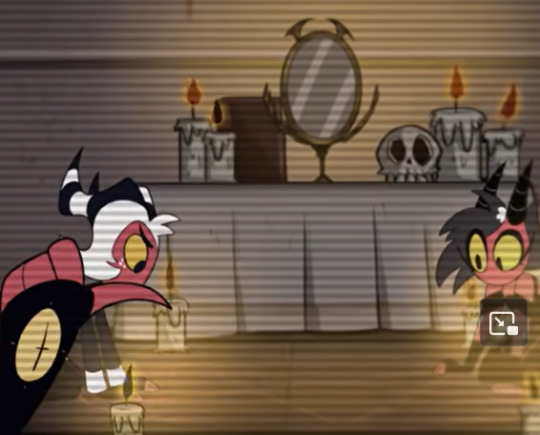
Drawing pentagrams on the floor, so as to make portals to Earth!
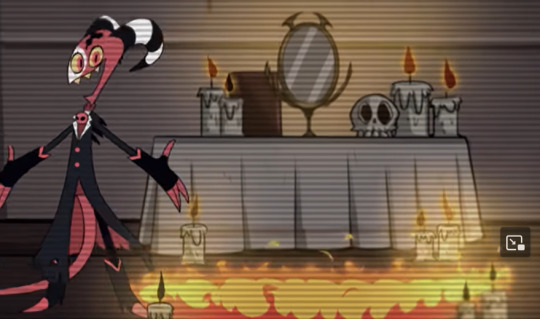
It's a little hard on the architecture, and the candles, skulls, and Special Chalk definitely don't come for free (they might end up on a Government Watch-List of some kind over the chalk, actually), but if it works, it works!
But that's not the only way to get out of Hell! There's also...
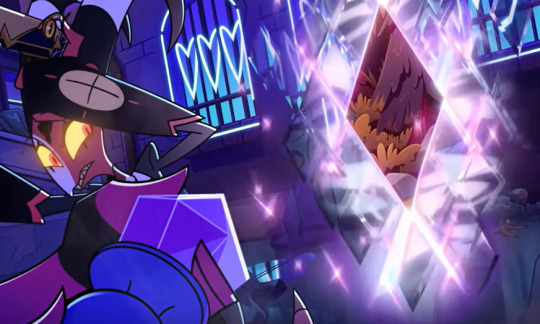
Asmodean Crystals! Which are NOT as rare as you might think, in the Lust Ring...

IF the Officially Registered & Authorized User can be persuaded to let you use it, of course!
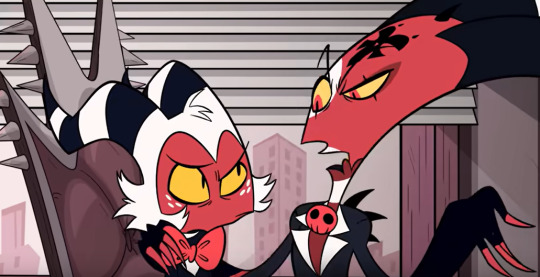
While Moxxie might debate about whether or not spending $$$ on dates with Succubi & Incubuses counts as a "Business Expense,"

Blitz would like to state, for the record, that it's the easiest way to convince them to let I.M.P borrow the magic rocks...
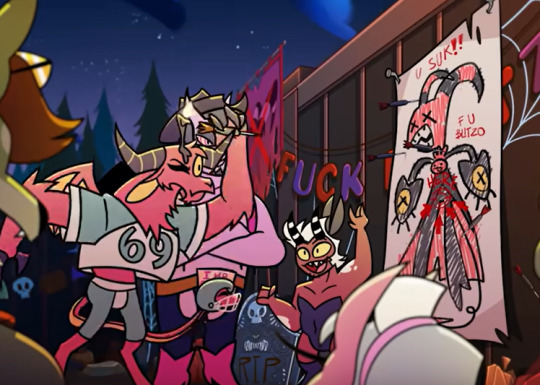
Unfortunately, it may not be a sustainable business-model either way. Because Blitzo's Exes have started comparing notes, and Moxxie & Millie REFUSE to compromise on their "monogamy" thing for the Business!
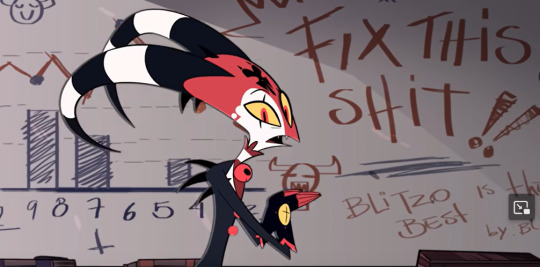
S0! ANY IDEAS on how to get to Earth without having to blackmail and/or woo Legitimate Crystal-Owners into letting us borrow (or "borrow") the magic rocks for work?
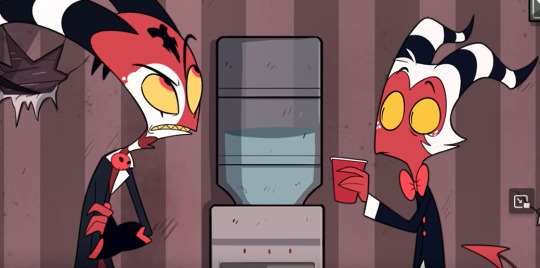
The Magic Chalk & Candles is EXPENSIVE and it takes FOREVER to draw the pentagram just-so, and they ain't got budget to pay overtime, people, so let's think creatively! Can we think of ANY other way to access the Living World?
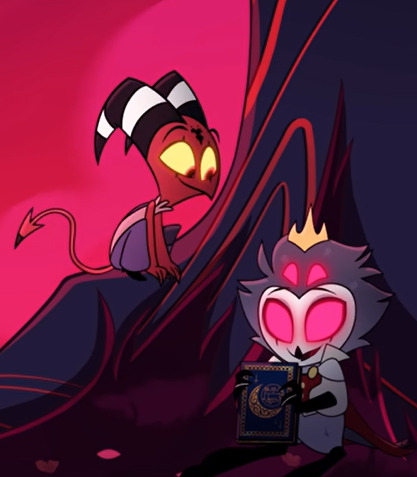
...Wait. I think I remember something. Something useful. Isn't there a Prince with a Magic Spellbook that can be used for this kind of thing?

Millie knows what he's talking about. She's seen that Spell Book in action, at the Harvest Moon Festival every year.
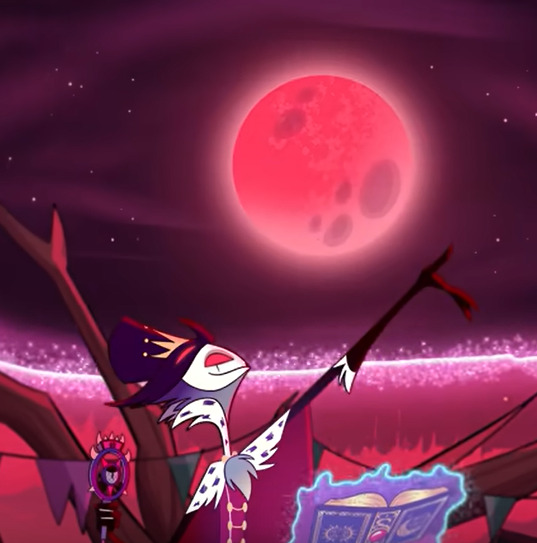
It's an easy ticket to Earth, if they can just find a way to TAKE it...
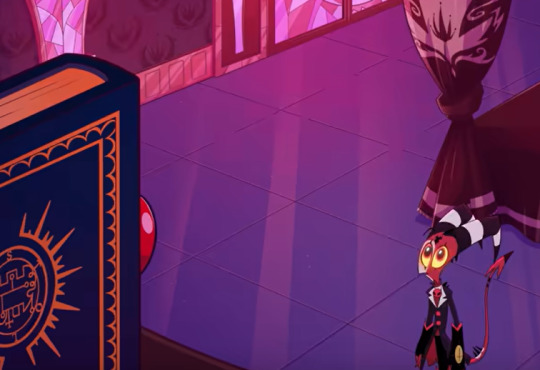
No overhead for magic chalk & candles; no expenses from buying dinner and drinks and tickets to try and sweet-talk some sucker into letting them borrow a crystal; (no Millie saying that he "just hasn't met the right person yet" when they call him inevitably call him a user & a loser and kick him to the curb)...

Can't be that hard to persuade Prince Stolas to let them borrow the book for a bit, right?
It beats going back to taking targets in Hell (lots of competition, and High Pay = High RISK), or doing Security Detail or Body-Guarding again, and he's sure Millie left the Family Farm for a REASON, just like he left Show Business for a reason, and Moxxie won't talk about why he won't show his face in the Greed Ring nowadays...
#helluva boss#immediate murder professionals#imp#blitz#blitzo#this is for anyone who thinks Blitz was FORCED to take the Full Moon Deal#he had other options#it kept the lights on#but there were always other ways to achieve that
29 notes
·
View notes
Text
Sims 3 - Gameplay enhancing mods: Family, Occults, School, Work - Part 2.
Continuation of our category based mods. Includes Family, Occult, School, Work/Careers categories.
Pregnancy:
More Pregnancy Interactions
Occults:
Gain weight after pregnancy
Children & Teens:
OneEuroMutt's list of kids through teens mods
Better Bloom Interaction
Autonomous Alchemy Stations
No Temporary Zombies
Mermaid Hunger and "Drying Up" Moodlet Tweaks [Five Flavors!]
Not-So-Weak Mummies
Vampires Are Not Kind! (Drink Without Permission)
Spell Book Tweaks, with multiple flavors (Updated for Carousel, Mill and Gondola)
Magic Academy / Dark Magic Academy Career
Faerie High
Bernardi Academy (Werewolf High)
Fortuneteller Baba's High School for Witches
Fortuneteller Baba's Elementary School for Witches
Vampire Covenant - Requested Career
Spells with increased chances of freezing and blazing
School:
Turtle Martial Arts High School
ClaudiaSharon's Simblr: Evening School, a mod (tumblr.com)
Work:
Architecture Career (TS2 Conversion)
Gamer Career - converted from The Sims 2
Oceanography Career - A TS2 to TS3 Conversion
Sims 3 Custom Career: Law (From the Sims 2: Seasons). Fulltime.
Turles Crusher Corps. Career
Custom Career - Hawaii 5-0 Reboot
Law & Order: Special Victims Unit (based on TV Show)
Garbage Collector Custom Career
The Mechanical Engineering Career
The Navy Officer Career! (With Mass Effect References.)
Car Dealership Career
Entrepreneur Career
Sims 3 Custom Career: Show Business
Professional Wrestling Career
Boxer Career [TS3]
Ninja Career v1.01
Hockey Career
NFL Career
MLB Career
NASCAR Career
Teen Modelling
The Modeling Career
The Socialite Career
Gynaecology Career
Oncologist Career - Converted from lientebollemeis career
Rapper Career - Converted from coko career
Nectar Career
Mad Scientist Career
Professional Procrastinator Career
The Professor Career - Custom Everything!! Outfit, Journals, Opportunities, et. al
Tourism Career -- With Opportunities & MOAR
Night Stalker Career
Psychology Career
Hunting Career
Sims 3 Veterinary Career
Monk/Nun Part-time Career
Sims 3 Priest Career - Full Time
Pirate Career & School
Different Job Titles For Careers
New Job Titles And Descriptions
111 notes
·
View notes
Text
#3d modeling companies in usa#3d modeling services architecture#3d building modelling services#3d industrial modeling services#professional 3d animation services
0 notes
Text
Hiranandani Fortune City, Panvel: Redefining Luxury and Sustainability in Navi Mumbai

Hiranandani Fortune City, Panvel, is a thoughtfully designed integrated township that combines modern luxury with sustainable urban living. Developed by Hiranandani Communities, this township is a benchmark for eco-friendly and sophisticated living in Navi Mumbai. The project seamlessly integrates residential, commercial, and retail spaces, offering an upgraded lifestyle to homeowners and a lucrative investment opportunity. With a strong emphasis on Hiranandani sustainability, the township is designed to minimize environmental impact while maximizing comfort and convenience for its residents. As Navi Mumbai continues to grow as a business and residential hub, Hiranandani Panvel stands out as a premier destination for those seeking a well-connected and future-ready township.
Strategic Location & Connectivity
One of the most compelling aspects of Hiranandani Fortune City is its prime location in Panvel, making it an ideal residential and commercial hotspot. The township is strategically positioned near the Mumbai-Pune Expressway, JNPT, and Navi Mumbai International Airport, ensuring seamless connectivity to major economic centers. It is well-connected through Mohape and Panvel railway stations, making commuting hassle-free for working professionals. The upcoming Mumbai Trans-Harbour Link (MTHL) and metro projects will further enhance accessibility, positioning Hiranandani Panvel as a future-ready township. With easy access to commercial and industrial zones, this development caters to professionals and entrepreneurs seeking a well-connected and dynamic living environment.
Architectural Excellence & Thoughtful Planning
Hiranandani Fortune City is a master-planned township featuring architecturally stunning residences, commercial hubs, and retail spaces. The township offers spacious studio, 1, 2, and 3 BHK apartments, designed with modern aesthetics and premium finishes. With a strong focus on Hiranandani sustainability, the project integrates tree-lined avenues, landscaped gardens, and energy-efficient buildings, ensuring an eco-conscious and luxurious lifestyle. The township follows the Live-Work-Play philosophy, incorporating corporate parks, high-street retail outlets, and entertainment zones, creating a self-sustained community for its residents.
Sustainable Living at Its Core
Hiranandani Panvel is not just about luxury; it is also a model of sustainable urban living. Hiranandani Communities has incorporated eco-friendly construction practices, water recycling systems, and renewable energy solutions to minimize environmental impact. The township features rainwater harvesting, sewage treatment plants, and green energy initiatives, reinforcing its commitment to sustainability. Residents benefit from large open green spaces, themed gardens, and tree plantations, which enhance air quality and promote a healthy living environment. By integrating Hiranandani sustainability initiatives, this township ensures a greener and healthier lifestyle for its residents.
Luxury & Lifestyle Amenities
Hiranandani Fortune City, Panvel, is designed to provide an unparalleled living experience with a wide range of luxury amenities. The township features world-class clubhouses, wellness centers, and landscaped gardens, offering a serene escape from the hustle of city life. Residents have access to state-of-the-art sports facilities, including swimming pools, gymnasiums, jogging tracks, and recreational courts. Retail and entertainment hubs within the township provide convenience at residents' doorsteps, eliminating the need to travel far for essential services and leisure activities. Whether it’s fine dining, shopping, or wellness, Hiranandani Panvel offers a holistic and premium lifestyle.
A Thriving Community & Future Prospects
The real estate market in Panvel is witnessing rapid growth, making Hiranandani Fortune City an attractive investment option. With Navi Mumbai’s expanding infrastructure, increased commercial activity, and growing residential demand, the township is poised for long-term appreciation. The integrated township model ensures a balanced lifestyle with employment hubs, educational institutions, healthcare facilities, and recreational zones all within close proximity. As a part of Hiranandani Communities, the township continues to evolve, adding value to residents and investors alike. Its strategic location, top-tier amenities, and sustainability-driven planning make Hiranandani Panvel a benchmark for modern urban development.
Conclusion
Hiranandani Fortune City, Panvel, is more than just a township; it is a vision for the future of luxury and sustainable living. Developed by Hiranandani Communities, this project blends modern infrastructure, premium amenities, and eco-friendly initiatives, setting new standards in real estate. As Panvel emerges as a key urban center, this township offers a perfect blend of connectivity, comfort, and long-term value. Whether you are looking for a home or an investment, Hiranandani Panvel provides an unparalleled opportunity to be a part of a thriving, future-ready community.
10 notes
·
View notes
Text
Niranjan Hiranandani’s Vision for Panvel: Pioneering a New Era of Urban Living

Panvel is rapidly emerging as the next major hub for urban development, thanks to the Mumbai 3.0 expansion. As the gateway to Navi Mumbai, Panvel is benefiting from large-scale infrastructure projects, improved connectivity, and growing commercial opportunities. Recognizing its immense potential, Dr Niranjan Hiranandani has played a key role in transforming Panvel’s real estate landscape through Hiranandani Communities. With a focus on sustainability, integrated living, and modern infrastructure, Hiranandani Fortune City has redefined urban development in Panvel, creating a thriving township that blends convenience with quality of life.
Why Panvel? Understanding the Growth Potential
Panvel has become a preferred location for homebuyers, businesses, and investors due to its strategic connectivity and infrastructure expansion. Located near the Mumbai-Pune Expressway, Navi Mumbai International Airport, and JNPT, Panvel is set to become a high-growth corridor.
Several key infrastructure projects, such as the Mumbai Trans-Harbour Link (MTHL) and the Navi Mumbai Metro, are further enhancing Panvel real estate growth. The Panvel-Karjat Rail Corridor, RORO Services, and Coastal Road will ensure seamless connectivity, making the region attractive for professionals and businesses looking for a smart township in Panvel.
Hiranandani’s Master Plan for Panvel: A Smart & Sustainable Township
Dr. Niranjan Hiranandani envisions Panvel as a self-sufficient urban ecosystem. Hiranandani Fortune City, one of the largest Hiranandani Communities projects, is designed as a mixed-use development, integrating premium luxury apartments in Panvel, corporate parks, retail spaces, and entertainment hubs.
Sustainability is at the heart of the township, with eco-friendly architecture, green spaces, and energy-efficient infrastructure. By blending modern urban planning with environmental consciousness, Hiranandani Fortune City offers a model for future real estate developments in India.
Sustainable Living: A Core Element of Hiranandani Panvel
Hiranandani Panvel prioritizes eco-friendly living with initiatives like rainwater harvesting, sewage treatment plants, and renewable energy solutions. Smart design elements, such as tree-lined avenues, landscaped parks, and recreational zones, create a balanced and healthy environment for residents.
By incorporating green building materials and efficient water management systems, Hiranandani Fortune City aligns with global sustainability goals while offering residents a comfortable and environmentally responsible lifestyle.
Enhancing Connectivity: Making Panvel a Well-Connected Urban Hub
Seamless connectivity is a crucial aspect of Niranjan Hiranandani’s vision for Panvel. Upcoming infrastructure projects, such as the Navi Mumbai Metro, MTHL, and new highway expansions, will enhance accessibility to Mumbai and surrounding economic centers.
The expansion of railway stations and metro connectivity will significantly reduce travel time, making Hiranandani Fortune City an attractive location for professionals working in Mumbai, Navi Mumbai, and Pune. As urban development in Panvel accelerates, the township will be at the center of this transformation.
Luxury & Convenience: Redefining Urban Living in Panvel
Hiranandani Fortune City is designed to offer a premium lifestyle with top-tier amenities. Residents enjoy access to world-class clubhouses, modern fitness centers, swimming pools, and landscaped gardens. The township also features high-street retail, ensuring that daily conveniences are within reach.
Additionally, the presence of corporate workspaces and IT hubs makes Hiranandani Panvel a preferred choice for professionals seeking a well-balanced work-life experience. With residential, commercial, and recreational spaces integrated within the township, it exemplifies modern urban planning.
The Economic Impact: Panvel as a Thriving Business & Investment Destination
Under Dr. Niranjan Hiranandani’s leadership, Hiranandani Communities has played a pivotal role in shaping Panvel’s economic landscape. Special Economic Zones (SEZs) and IT parks are flourishing, creating thousands of employment opportunities.
Retail spaces within Hiranandani Fortune City are witnessing rising footfall, and commercial establishments are seeing increased demand. Investors are recognizing Hiranandani Panvel as a high-growth real estate destination, thanks to its long-term capital appreciation and rising rental demand.
What’s Next for Hiranandani’s Vision in Panvel?
Looking ahead, Hiranandani Communities plans to expand Hiranandani Fortune City further, integrating smart city solutions, AI-driven infrastructure, and digital connectivity. With continued investment in sustainable urban planning, the township will evolve to meet the demands of the next generation.
Dr. Niranjan Hiranandani envisions Panvel as a global urban destination, offering a balanced, future-ready lifestyle for residents and businesses. As more infrastructure projects are completed, Hiranandani Fortune City will continue to be at the forefront of Panvel real estate growth.
Conclusion: A New Era of Urban Excellence in Panvel
Dr. Niranjan Hiranandani has transformed Hiranandani Panvel into a benchmark for smart townships in Panvel. With a focus on sustainability, connectivity, and quality of life, Hiranandani Fortune City is not just a residential township but a self-sufficient urban ecosystem.
As Panvel real estate growth continues, Hiranandani Communities remains committed to building luxury apartments in Panvel that offer a world-class living experience. With its strategic location, strong infrastructure, and sustainable development model, Hiranandani Panvel is set to become one of the most sought-after real estate destinations in India.
FAQs
1. What is Niranjan Hiranandani’s vision for Panvel’s future?
Dr. Niranjan Hiranandani envisions Panvel as a smart, sustainable urban hub with world-class residential, commercial, and infrastructure developments.
2. How does Hiranandani Fortune City contribute to Panvel’s development?
Hiranandani Fortune City is a mixed-use township that integrates residential, commercial, and recreational spaces, promoting sustainable and integrated urban growth.
3. Why is Panvel becoming an investment hotspot?
With upcoming projects like the Mumbai Trans-Harbour Link, Navi Mumbai Metro, and new business parks, Panvel is experiencing rapid infrastructure development, making it an attractive investment location.
4. What sustainability initiatives are part of Niranjan Hiranandani’s projects?
Hiranandani Communities incorporates rainwater harvesting, energy-efficient designs, green spaces, and eco-friendly construction materials to promote sustainable urban living.
5. How will Panvel’s connectivity improve in the coming years?
Panvel will see improved connectivity with the Mumbai Metro, enhanced railway corridors, and expressway expansions, reducing travel time to key business districts.
9 notes
·
View notes